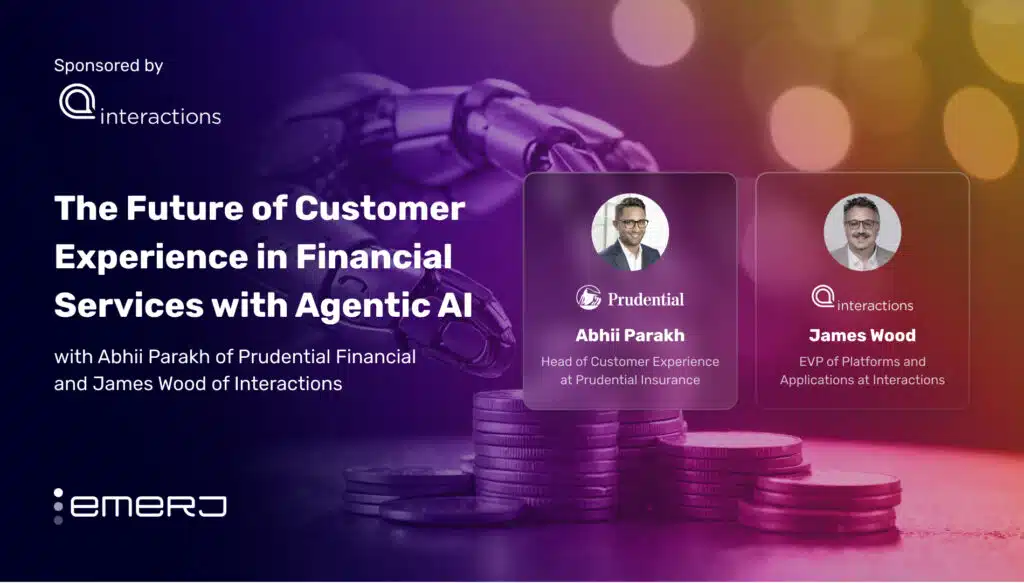This article is sponsored by Interactions and was written, edited, and published in alignment with our Emerj sponsored content guidelines. Learn more about our thought leadership and content creation services on our Emerj Media Services page.
Low customer engagement is a persistent challenge in the insurance sector, particularly with policies held for an extended period. Research from the Society of Actuaries highlights that after the initial purchase, many policyholders have minimal interaction with their insurer, resulting in underutilized benefits and missed opportunities for upselling or retention.
Outdated, reactive customer service models compound this lack of ongoing engagement. Insurers typically only interact with customers when a claim is made or a payment is missed, missing vital touchpoints that could deepen relationships and enhance customer lifetime value.
AI-driven solutions are already transforming customer engagement in other sectors, and bringing them to insurance can help by creating more meaningful, conversational experiences beyond traditional, transactional interactions.
As Interactions’ blog highlights, integrating advanced conversational AI and human-in-the-loop support enables businesses to deliver real-time, context-aware, and personalized responses across multiple channels.
A hybrid approach streamlines self-service and ensures that each customer touchpoint is engaging and human-like, helping companies build trust, satisfaction, and operational efficiency while reducing costs.
Emerj Editorial Director Matthew DeMello recently sat down with Abhii Parakh, Head of Customer Experience at Prudential Financial, and James Wood, EVP of Platforms and Applications at Interactions, to discuss how AI can be leveraged to enhance customer experience in insurance through proactive, personalized service while balancing risk and human oversight.
Their conversation highlights the shift from reactive to proactive engagement, the importance of use-case-driven AI design, and the need for transparency and human-in-the-loop systems to maintain trust.
This article examines two critical insights for CX leaders from their conversation:
- Moving from reactive to proactive customer engagement: Proactively guiding customers on overlooked benefits based on their policy history helps move beyond reactive support and builds long-term trust with AI.
- Building outcome-driven agentic AI with human oversight: Designing agentic AI to use tools autonomously for outcomes, but always including humans-in-the-loop for complex or high-risk tasks.
Guest: Abhii Parakh, Head of Customer Experience, Prudential Financial
Expertise: Customer Experience, Leadership, Strategy
Brief Recognition: Abhii has over 20 years of experience leading digital, marketing, and customer experience functions for Fortune 100 companies. He has built, scaled, and matured customer-centric and digital capabilities in his current role, including driving the company’s award-winning global CX transformation. He holds a Master’s degree in Business Administration from Georgetown University.
Guest: James Wood, EVP of Platforms and Applications, Interactions
Expertise: Conversational AI, Business Transformation
Brief Recognition: James is a technology leader with over 20 years of experience building high-performing teams, developing products, and leading large-scale implementations. In his current role, he heads the Conversational Design, Development, and QA functions, driving the delivery of intelligent virtual assistant (IVA) solutions. He holds a Bachelor’s degree in Engineering from the University of Auckland.
Moving from Reactive to Proactive Customer Engagement
Abhii begins the discussion by reflecting on how reactive systems will always be a part of the life insurance business — when an incident occurs, such as a death, the company must respond. However, he points out that modern life insurance is more than a death benefit. Today’s policies often offer cash value accumulation, tax advantages, and estate planning benefits, meaning they serve customers in many ways beyond being reactive in one’s claims moments.
He then makes a key distinction: being reactive and responsive is good, but being proactive makes a company great. He says companies shouldn’t just wait for customers to reach out. To serve them well, they must anticipate needs and provide proactive, helpful information:
“Many life insurance policies were sold decades ago by advisors no longer in the business. Most policyholders don’t remember what they purchased or how their coverage works. If you’re simply reacting when a claim is made, that’s acceptable — but it’s not exceptional. Great customer experience means using blending human connections with AI capabilities to proactively engage policyholders with personalized guidance based on their individual policy, how long they’ve had it, and their current needs.”
– Abhii Parakh, Head of Customer Experience at Prudential Financial
In discussing adopting new technology in financial services, Abhii explains that Prudential’s use of AI has been successful internally. They’ve seen it work accurately, without hallucinations, and under strict controls. Being in a highly regulated industry, they undergo rigorous risk assessments and due diligence processes. So far, the results have proven that AI can be both productive and reliable in internal use.
However, his team is proceeding with more caution when it comes to customer-facing applications. Since this space is still relatively unproven, they are moving forward enthusiastically but carefully, especially for tasks where mistakes can have serious consequences, such as payment processing. In such cases, they ensure that a human is kept in the loop to prevent errors.
James agrees with Abhii that risk assessment and compliance are essential and says his team is equally used to working within those guardrails. However, he emphasizes that the level of risk ultimately depends on the specific use case.
James cites that, as an example, if AI is used to identify customers who have held a policy for a long time and might benefit from a check-in or product suggestion, that is likely a low to medium risk. It’s the sort of task where outreach can be automated without much concern.
However, he agrees with Abhii that there are higher-risk scenarios, such as handling payments, where using a purely generative AI model could be hazardous. Such models might “hallucinate” numbers or fail to meet compliance standards, such as PCI, which is a serious issue when handling sensitive financial information.
Building Outcome-Driven Agentic AI with Human Oversight
Moving to agentic AI, James points out that while many companies now call themselves agentic AI companies, the term has a specific meaning: it refers to AI systems that can autonomously use various tools to solve problems and work toward outcomes rather than just generating responses.
He sees the next evolution of generative AI as moving from passive, prompt-based systems to AI that can decide which tools to use, in what order, and with what input to complete more complex, outcome-driven tasks.
In customer service, his team is already leveraging some of the predictive AI capabilities in the space, such as automating payments. They are now exploring how to make these systems more flexible and intelligent, capable of handling variations and making decisions on the fly.
Significantly, James notes that one of their first agentic use cases is keeping humans in the loop, using agentic AI to proactively involve human oversight at the right moments rather than eliminating it.
Abhii responds in kind, explaining that while agentic AI is a popular term, he has yet to see a truly autonomous, multimodal goal-oriented AI system that can act independently with memory and context in an enterprise-grade setting.
Much of what is being marketed as agentic AI still functions more like basic chatbots or traditional AI, meaning it is helpful but incapable of fully carrying out tasks without oversight.
Abhii ties his point on agentic AI to the broader question of how companies are planning for human involvement in AI systems. Since these truly autonomous agents are not yet present, especially in customer-facing roles, the role of humans remains essential.
However, on the internal side, there are signs of progress. He describes early examples of “virtual employees” — AI systems that can operate within workflows, such as marketing, carrying out multi-step processes, including submitting and publishing content. These internal systems are starting to resemble agentic AI, performing practical actions across workflows with limited assistance:
“Even as AI systems carry out tasks and interact with other systems, the full workflow remains visible. That transparency allows human teams to monitor, intervene, pause, or adjust the process in real-time. While we haven’t seen truly autonomous agentic systems in the enterprise yet, there are emerging use cases where we’re placing humans in the loop to ensure oversight and control as these technologies evolve. Essentially, some tasks have traditionally been done by humans that take time and aren’t customer-facing. In the future, some of those manual and time-consuming tasks can be done with Agentic AI. This can help teams have more time to focus on what matters, making human connections.”
– Abhii Parakh, Head of Customer Experience at Prudential Financial



















